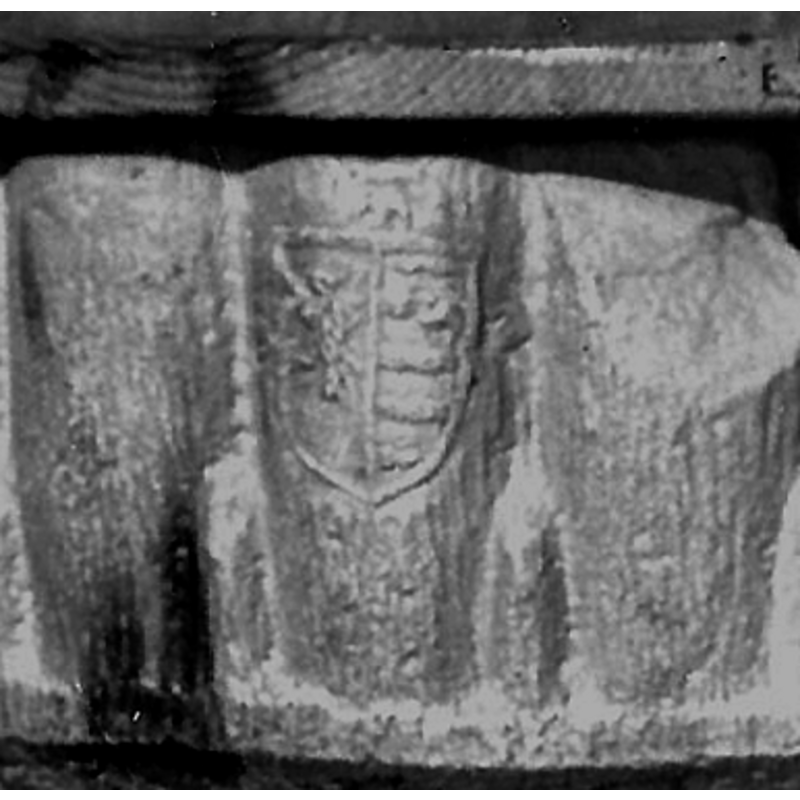Eransus

Image copyright © Institución Príncipe de Viana, 2003
Image and permission received (file letter of June 2001)
Results: 10 records
coat of arms - Sarabia family
Scene Description: Domeño (1992: 41) suggests that the shield was carved in the 16th century on this 13th-century font
Copyright Statement: Image copyright © Institución Príncipe de Viana, 2003
Image Source: detail of a Photograph [ca. 1943], Institución Príncipe de Viana, Archivo Uranga
Copyright Instructions: Image and permission received (file letter of June 2001)
design element - motifs - moulding - patterned - scalloped
design element - patterns - ribbed
design element - patterns - ribbed
human figure - head - 4?
view of church exterior - north view
view of church exterior - portal
view of church interior - nave - looking east
view of font and cover
INFORMATION
FontID: 04665ERA
Object Type: Baptismal Font1
Church/Chapel: Iglesia Parroquial del Salvador
Church Patron Saints: Our Saviour
Country Name: Spain
Location: Navarra, Comunidad Foral de Navarra
Directions to Site: [abandoned village] Located in the municipality of Egüés, Merindad de Sangüesa
Historical Region: Valle de Egüés
Font Location in Church: Under the choir
Century and Period: 13th century (early?) / 16th century[recarved in the 16th?], Romanesque
Workshop/Group/Artisan: heraldic font [recarved?]
Cognate Fonts: The basin is similar, though not identical, to those of the fonts at Ardanaz de Egüés and Elcano, both in Navarra
Credit and Acknowledgements: We are grateful to the Institución Príncipe de Viana and the photographers Larrión & Pimoulier, of Pamplona, Spain, for the images of this font
Font Notes:
Click to view
Described and illustrated in the Catálogo Monumental de Navarra (1990?-) and in Domeño (1992): baptismal font of the early 13th century [although the coat of arms on it should be dated to the 16th century]; the ribbed cylindrical basin is separated from the hemispheric underbowl by a scalloped moulding; a shield with a coat of arms is visible on one of the upper ribs at the front; identified in Domeño (ibid.) as the arms of the Sarabia family, which may have been added in the 16th century to this earlier-dated font; the base has eight colonnettes in a square, wrapping the central shaft, with crude heads carved at the upper end; some damage to the upper side of the basin side, at the rim, where the iron staple of the old cover has been torn off. A plain flat wooden lid covers the font now. Noted in García de Castro Valdés ([s.d.] 1998?) The Enciclopedia del románico en Navarra (2008) notes a few Navarrese fonts with similar -though not identical- decoration in Cabanillas, Ardanaz de Egues, Esparza de Galar, Lorca, Eransus and Zunzarren. Noted in Plazaola Artola (2008?). NB: Despoblados Navarra informs that the church had been broken into and robbed of anything of value; the font appears to be gone ["En la iglesia del Salvador, o de la Asunción, no es la primera ni la segunda vez, ni tan siquiera la tercera, que entran a robar. Se llevaron en su día (octubre de 1994) varias imágenes, y lienzos, y la pila bautismal, y también el aguabenditera; en otra ocasión las campanas (1995), y finalmente han acabado por llevarse lo poco que quedaba. Ahórrense los ladrones nuevos viajes, que ya no queda nada, ni tan siquiera los enchufes. Hay quien dice que no siempre han sido los ladrones los que se han llevado las cosas; que tal vez las campanas se ausentaron con ciertos beneplácitos. Desconozco en todo este proceso de expolio que ha vivido esta iglesia que papel ha jugado el Arzobispado y los propietarios del lugar, enfrentados en su día por un problema de propiedad. Doy por hecho que en su momento habrían sacado de allí todo lo que entendieron que era de valor, aunque debo de decir que, si así fue, su entendimiento y el mío no coinciden. Allí se quedaron hasta hace muy pocos días las dos aras que en el altar cobijaban las reliquias, allí se quedó la funda de tela de esas reliquias, allí se quedaron las sacras con sus marcos de latón dorado y su textos en latín, y las viejas casullas, algún alba, estolas, los cubrecáliz, los paños del altar con artísticas puntillas, paños para cubrir las fuesas…; todo ello de una antigüedad notoria" [Fernando Hualde, Diario de Noticias, 27 de febrero de 2006] [http://despobladosnavarra.blogspot.com.ar/2009/10/eransus.html] [accessed 5 December 2013]. A later source updating the repairs carried out to the church building by a group of local volunteers [http://iglesiasansalvadordeeransus.blogspot.ca/] [accessed 10 December 2013] shows repairs to the interior of the church; the old font, however, is no longer in it.
COORDINATES
UTM: 30T 4742673 621698
MEDIUM AND MEASUREMENTS
Material: stone
Number of Pieces: two?
Font Shape: cylindrical (mounted)
Basin Interior Shape: round
Basin Exterior Shape: round
LID INFORMATION
Date: modern
Material: wood
Apparatus: no
Notes: flat and plain
REFERENCES
Gran enciclopedia Navarra (11 vols.), Pamplona: Caja de Ahorros de Navarra, 1990
Domeño Martínez de Morentín, Asunción, Pilas bautismales medievales en Navarra, Pamplona: Gobierno de Navarra, 1992
Fundación Santa María la Real, Enciclopedia del románico en Navarra, Aguilar de Campoo: Fundación Santa María la Real, Centro de Estudios del Románico, 2008
García Gainza, María Concepción, Catálogo monumental de Navarra, Pamplona: Gobierno de Navarra, Arzobispado de Navarra, Universidad de Navarra, [1990?]
García de Castro Valdés, César, "Nuevas piezas de arqueología cristiana altomedieval en Asturias", 7 (2000), Revista de Arqueología del Área de Historia Medieval, 2000, pp. [201]-218; p. 209-210
Plazaola Artola, Juan, "El arte gótico en Euskal Herria", hiru.com [Etengabeko Ikaskuntza], [2008?]



